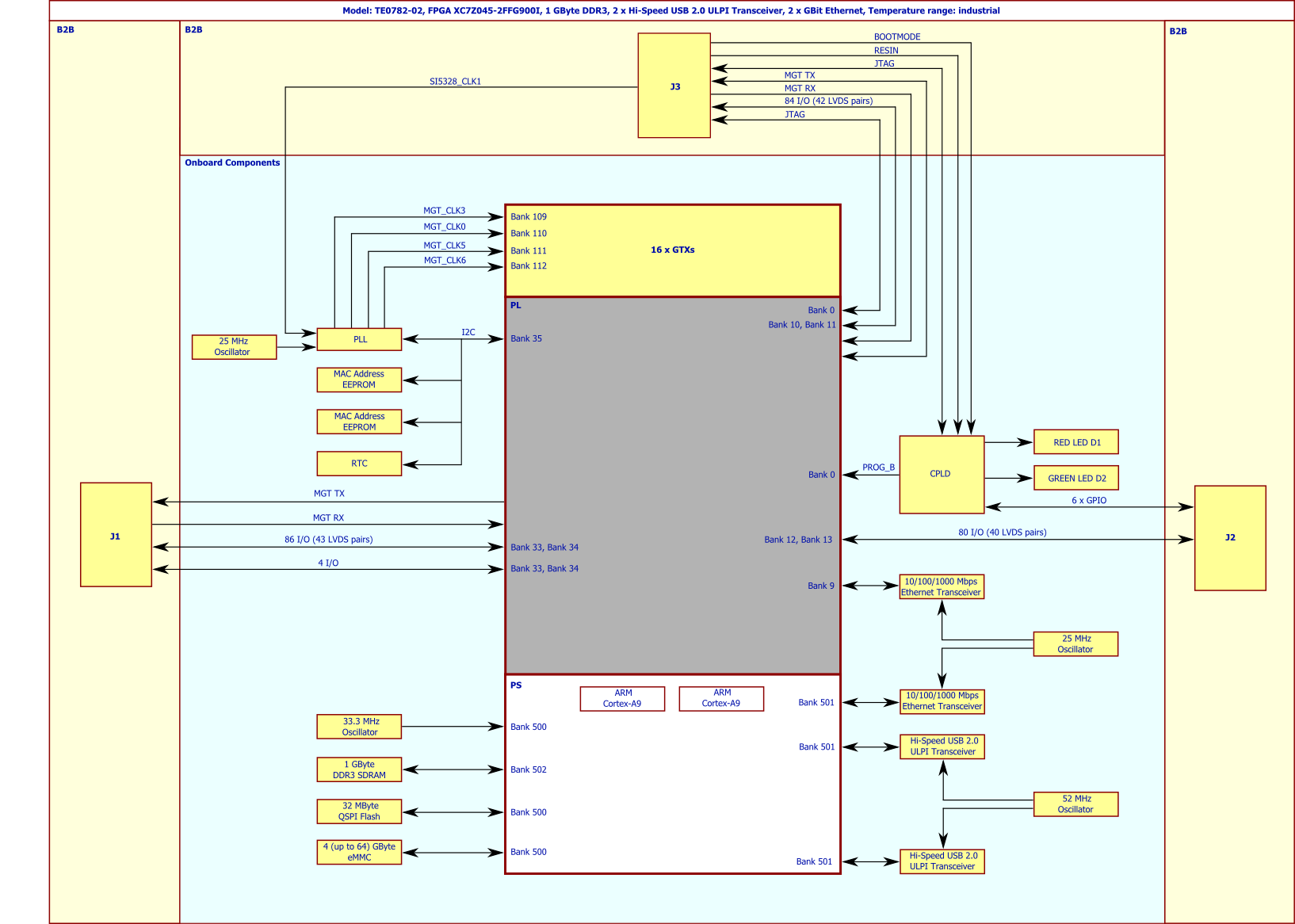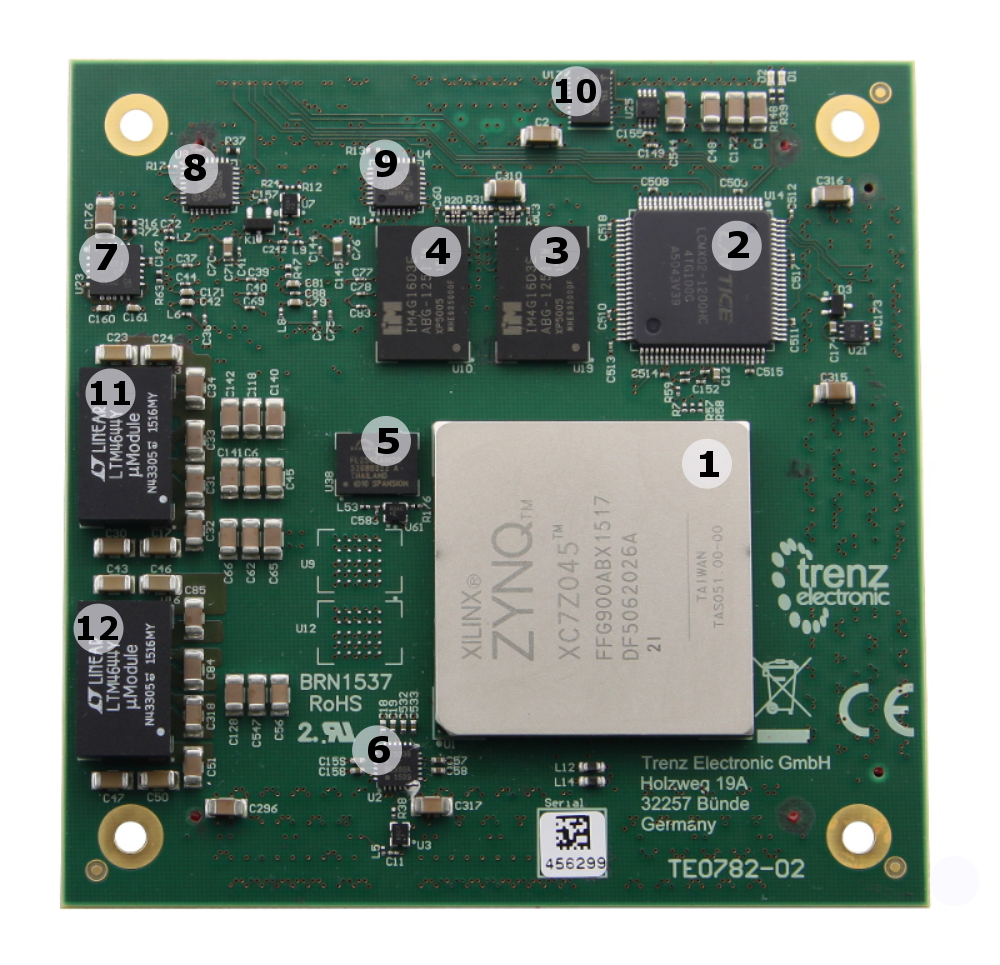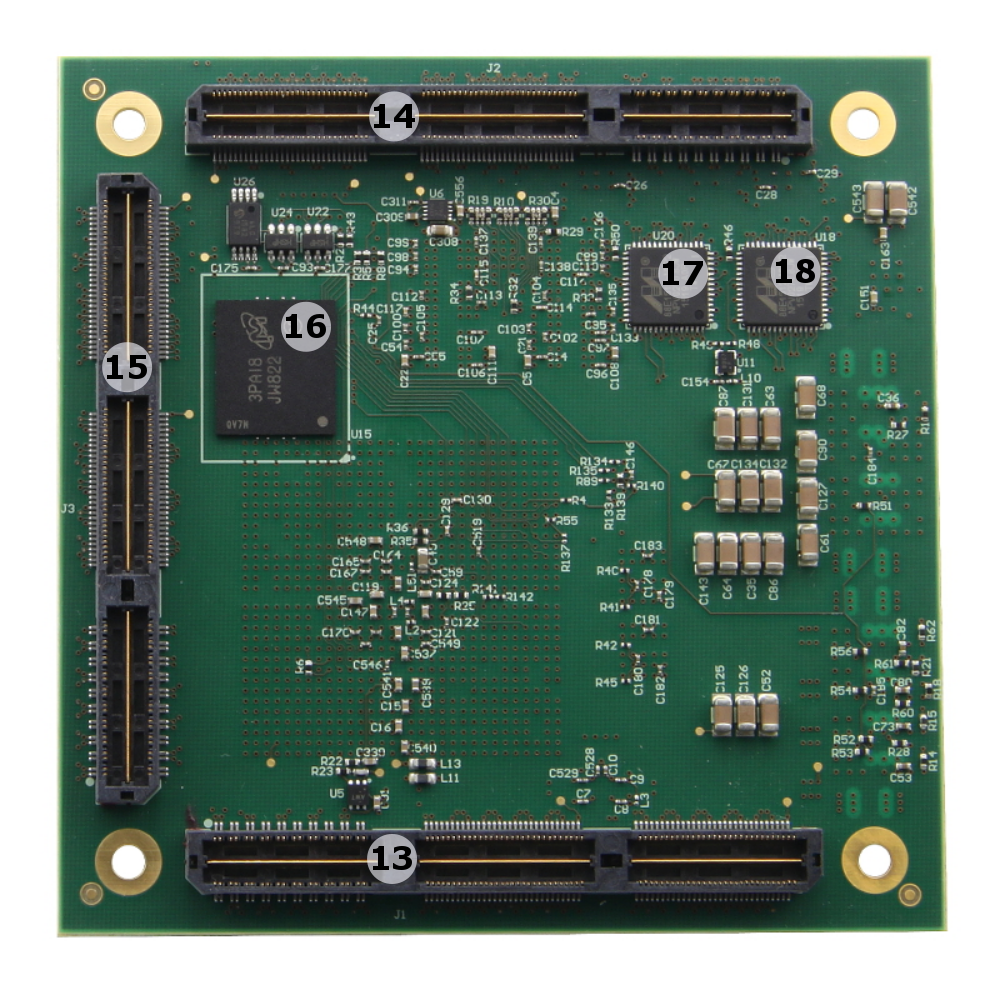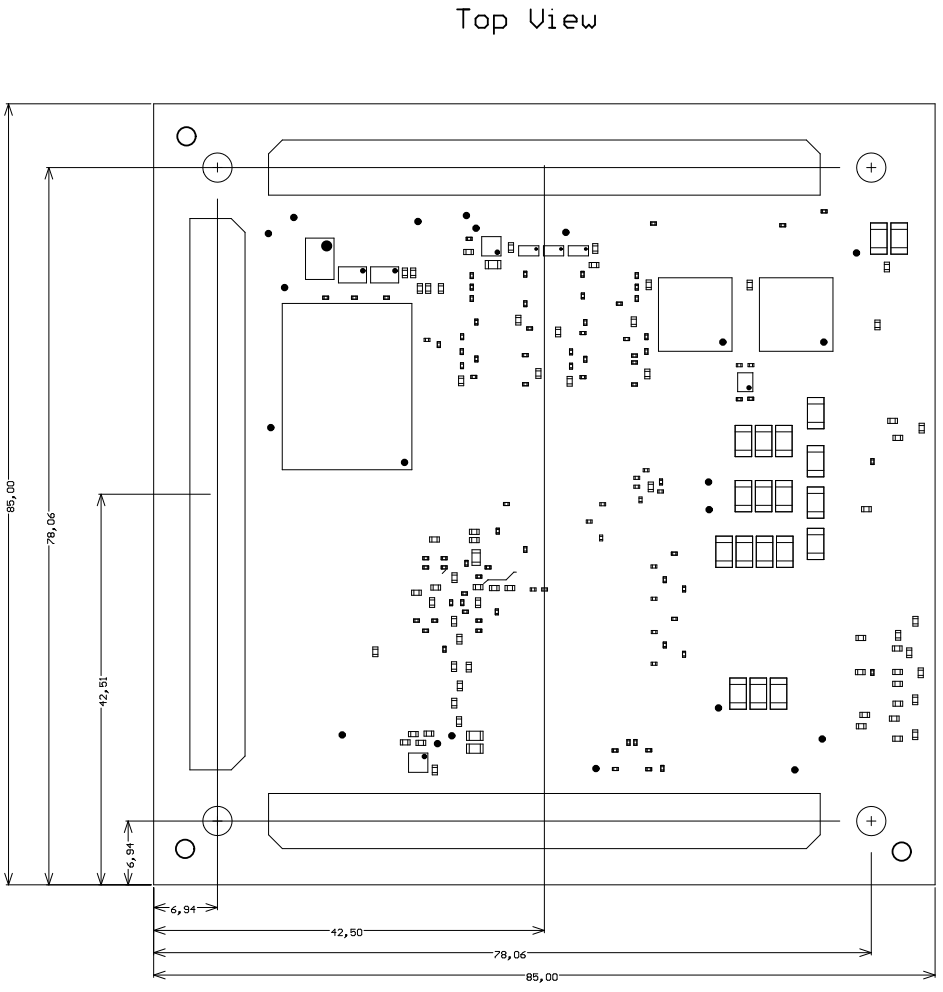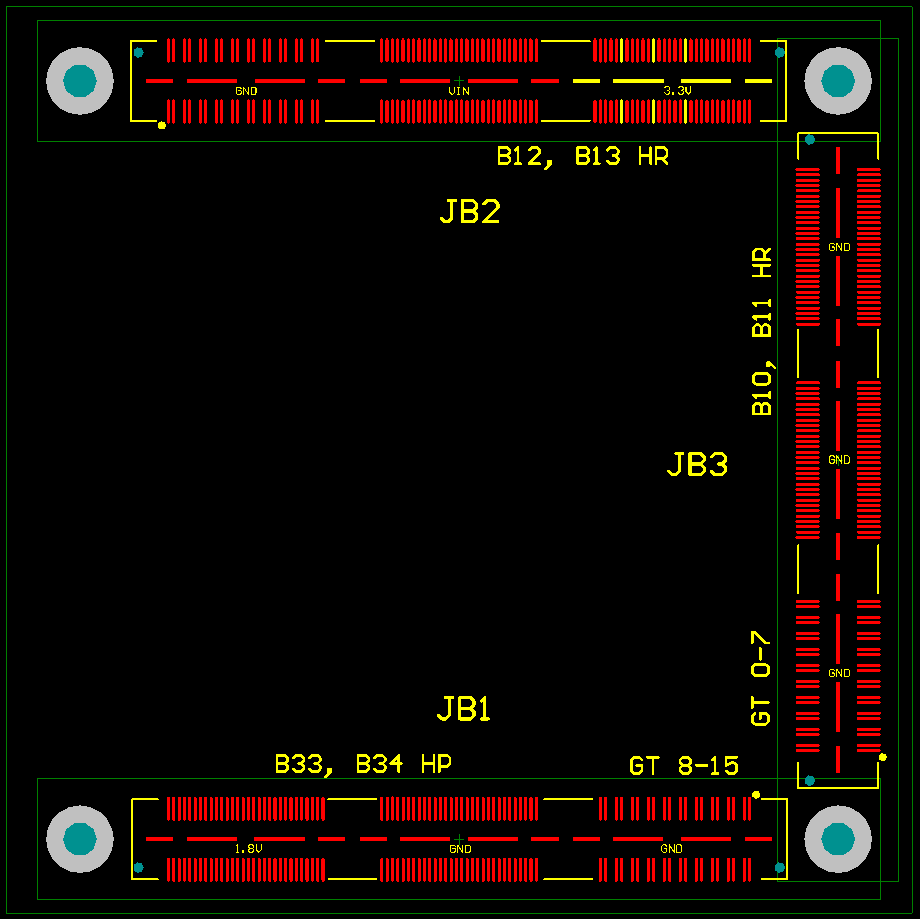Table of Contents
Overview
The Trenz Electronic TE0782 is a high-performance, industrial-grade SoM (System on Module) with industrial temperature range based on Xilinx Zynq-7000 SoC. It is equipped with a Xilinx Zynq-7 (XC7Z035, XC7Z045 or XC7Z100).
These highly integrated modules with an economical price-performance-ratio have a form-factor of 8,5 x 8,5 cm and are available in several versions.
All parts cover at least industrial temperature range of -40°C to +85°C. The module operating temperature range depends on customer design and cooling solution. Please contact us for options and for modified PCB-equipping due increasing cost-performance-ratio and prices for large-scale order.
Block Diagram
Main Components
The SoM TE0782-02 has following components on board:
- Xilinx Zynq-7 XC7Z035, XC7Z045 or XC7Z100 SoC
- Lattice Semiconductor MachXO2 1200HC System Controller CPLD
- Intelligent Memory 512 MByte DDR3L-1600 SDRAM (8 Banks a 32 MWords, 16 Bit Word-Width)
- Intelligent Memory 512 MByte DDR3L-1600 SDRAM (8 Banks a 32 MWords, 16 Bit Word-Width)
- Spansion 32 MByte QSPI Flash Memory
- SI5338A PLL programmable clock generator
- TI Low-Dropout Linear Regulator @1.5V
- Microchip USB3320 USB-Transceiver
- Microchip USB3320 USB-Transceiver
Intersil ISL12020MIRZ Real-Time-Clock
- LT Quad 4A PowerSoC DC-DC Converter @1.0V
LT Quad 4A PowerSoC DC-DC Converter @3.3V, @1,8V, @1.2V_MGT, @1.0V_MGT
- Samtec ASP-122952-01 160-pin stacking strips (2 rows a 80 positions)
- Samtec ASP-122952-01 160-pin stacking strips (2 rows a 80 positions)
- Samtec ASP-122952-01 160-pin stacking strips (2 rows a 80 positions)
Micron Technology 4 GByte eMMC
- Marvell Alaska 88E1512 Gigabit Ethernet PHY
- Marvell Alaska 88E1512 Gigabit Ethernet PHY
Key Features
- Xilinx Zynq-7 XC7Z035, XC7Z045 or XC7Z100 SoC
- Rugged for shock and high vibration
- large number of configurable I/Os is provided via rugged high-speed stacking strips
- Dual ARM Cortex-A9 MPCore
- 1 GByte RAM (32-Bit wide DDR3)
- 32 MByte QSPI Flash memory
- 2 x Hi-Speed USB2.0 ULPI transceiver PHY
- 2 x Gigabit (10/100/1000 Mbps) Ethernet transceiver PHY
- 4 GByte eMMC (optional up to 64GByte)
- 2 x MAC-Address EEPROMs
- optional 2 x 8 MByte HyperRAM (max 2 x 32 MByte HyperRAM) or optional 2 x 64 MByte HyperFLASH
- Temperature compensated RTC (real-time clock)
- Si5338 PLL for GTX Transceiver clocks
- Plug-on module with 3 x 160-pin high-speed strips
- 16 GTX high-performance transceiver
- GT transceiver clock inputs
- 254 FPGA I/O's (125 LVDS pairs)
- On-board high-efficiency switch-mode DC-DC converters
- System management
- eFUSE bit-stream encryption
- AES bit-stream encryption
- Evenly-spread supply pins for good signal integrity
- User LED
Assembly options for cost or performance optimization available upon request.
Signals, Interfaces and Pins
System Controller CPLD I/O-Pins
Special purpose pins to configure and operate the System Controller CPLD (IC U14) used by TE0782:
| Name | Connection | Note |
|---|---|---|
| CLPD_GPIO7 | B2B | Function defined by CPLD Firmware (legacy name was BOOTMODE) |
| CLPD_GPIO6 | B2B | Function defined by CPLD Firmware (legacy name was CONFIGX) |
| JTAGENB | B2B | logic high enables CPLD JTAG pins, if low CPLD update is disabled |
| nRST_IN | B2B | active low System-reset input (old name RESIN) |
| CLPD_GPIO0 | B2B | Function defined by CPLD Firmware |
| CLPD_GPIO1 | B2B | Function defined by CPLD Firmware |
| CLPD_GPIO2 | B2B | Function defined by CPLD Firmware |
| CLPD_GPIO3 | B2B | Function defined by CPLD Firmware |
| CLPD_GPIO4 | B2B | Function defined by CPLD Firmware |
| CLPD_GPIO5 | B2B | Function defined by CPLD Firmware |
| CPLD_IO | PL |
Small CPLD controls some functions of the SoM, this CPLD can be updated by the end user if support is designed in on customer base.
Boot Modes
TE0782 supports primary boot from
- SPI Flash
Boot from on-board eMMC is also supported as secondary boot (FSBL must be loaded from SPI Flash).
JTAG Bootmode is always possible no matter the Zynq Boot mode selected.
JTAG
JTAG access to the Xilinx Zynq-7000 device is provided by connector J3.
| Signal | B2B Pin |
|---|---|
| TCK | J3: 141 |
| TDI | J3: 147 |
| TDO | J3: 148 |
| TMS | J3: 1142 |
CPLD-JTAG access to the Xilinx Zynq-7000 device is provided by connector J3.
| Signal | B2B Pin |
|---|---|
| M_TCK | J3: 81 |
| M_TDI | J3: 87 |
| M_TDO | J3: 82 |
| M_TMS | J3: 88 |
JTAGENB pin in J3 should be kept low or grounded for normal operation.
Clocking
Silabs Multisynth PLL Si5338 can deliver GT reference clocks to all 4 GT Banks. Additionally a GT Reference clock can be generated on the base board for any of the 4 GT Banks. There is reference clock available on the TE0782 for Si5338, optionally external reference clock can be supplied from the base.
| Clock | Frequency | IC | Zynq PS / PL | Notes |
|---|---|---|---|---|
| PS CLK | 33.3333 MHz | U61 | PS CLK | PS Subsystem main clock |
| 10/100/1000 Mbps ETH PHYs reference | 25 MHz | U11 | - | |
| USB PHY reference | 52 MHz | U7 | - | |
PLL reference | 25 MHz | U3 | - | |
GT REFCLK1 | - | B2B connector | BANK110, Pin AC7/AC8 | Externally supplied from base |
GT REFCLK4 | - | B2B connector | BANK111, Pin U7/U8 | Externally supplied from base |
| Si5338 CLK0 | U2 | BANK110, Pin AA8/AA7 | ||
| Si5338 CLK1 | U2 | BANK109, Pin AF10/AF9 | ||
| Si5338 CLK2 | U2 | BANK111, Pin W8/W7 | ||
| Si5338 CLK3 | U2 | BANK112, Pin N8/N7 |
Processing System (PS) Peripherals
| Peripheral | IC | Designator | Zynq PS / PL | MIO | Notes |
|---|---|---|---|---|---|
| QSPI Flash | S25FL256SAGBHI20 | U38 | PS QSPI0 | MIO1...MIO6 | - |
| ETH0 10/100/1000 Mbps PHY | 88E1512-A0-NNP2I000 | U18 | PS ETH0 | MIO16...MIO27, MIO52, MIO53 | - |
| ETH0 10/100/1000 Mbps PHY Reset | PS GPIO | MIO7 | ETH1_RESET33 (MIO7) -> CPLD -> ETH1_RESET | ||
| ETH1 10/100/1000 Mbps PHY | 88E1512-A0-NNP2I000 | U20 | BANK9, BANK35 | - | PHY can be used with soft Ethernet MAC IP also |
| ETH1 10/100/1000 Mbps PHY Reset | BANK35, Pin B15 | - | - | ||
| USB0 | USB3320C-EZK | U4 | PS USB0 | MIO28...MIO39 | - |
| USB0 Reset | PS GPIO | MIO0 | OTG_RESET33 (MIO0) -> CPLD -> OTG_RESET | ||
| USB1 | USB3320C-EZK | U8 | USB1 | MIO40...MIO51 | - |
| USB1 Reset | PS GPIO | MIO0 | OTG_RESET33 (MIO0) -> CPLD -> OTG_RESET | ||
| Clock PLL | Si5338 | U2 | BANK35, Pin L14/L15 | Low jitter phase locked loop | |
| e-MMC (embedded e-MMC) | MTFC4GMVEA-4M IT | U15 | SDIO0 | MIO10...MIO15 | - |
| HyperFlash RAM | S26KS512SDPBHI00x | U9 | BANK35 | - | optional 2 x 8 MByte HyperRAM (max 2 x 32 MByte HyperRAM) or optional 2 x 64 MByte HyperFLASH |
| HyperFlash RAM | S26KS512SDPBHI00x | U12 | BANK35 | - | as above |
| EEPROM I2C | 24LC128-I/ST | U26 | BANK35, Pin L14/L15 | - | - |
| EEPROM I2C | 24AA025E48T-I/OT | U22 | BANK35, Pin L14/L15 | - | MAC Address |
| EEPROM I2C | 24AA025E48T-I/OT | U24 | BANK35, Pin L14/L15 | - | MAC Address |
| RTC | ISL12020MIRZ | U17 | BANK35, Pin L14/L15 | - | Temperature compensated real time clock |
| RTC Interrupt | ISL12020MIRZ | U17 | - | - | RTC_INT -> CPLD |
| UART | PS UART | MIO8, MIO9 | forwarded to B2B by SC CPLD |
Default MIO mapping
| MIO | Configured as | B2B | Notes |
|---|---|---|---|
| 0 | USB Reset | - | CPLD used as level translator |
| 1 | QSPI0 | - | SPI Flash-CS |
| 2 | QSPI0 | - | SPI Flash-DQ0 |
| 3 | QSPI0 | - | SPI Flash-DQ1 |
| 4 | QSPI0 | - | SPI Flash-DQ2 |
| 5 | QSPI0 | - | SPI Flash-DQ3 |
| 6 | QSPI0 | - | SPI Flash-SCK |
| 7 | Ethernet Reset | - | CPLD used level translator |
| 8 | UART TX | JC3:129 | output, muxed to B2B by the SC CPLD |
| 9 | UART RX | JC3:135 | input, muxed to B2B by the SC CPLD |
| 10 | SDIO1 D0 | - | - |
| 11 | SDIO1 CMD | - | - |
| 12 | SDIO1 CLK | - | - |
| 13 | SDIO1 D1 | - | - |
| 14 | SDIO1 D2 | - | - |
| 15 | SDIO1 D3 | - | - |
| 16..27 | ETH0 | - | Ethernet RGMII PHY |
| 28..39 | USB0 | - | USB0 ULPI PHY |
| 40...51 | USB1 | - | USB1 ULPI PHY |
| 52 | ETH0 MDC | - | - |
| 53 | ETH0 MDIO | - | - |
Pin Definitions
Pins named _vrn and _vrp are connected to ZYNQ PL HP Bank special purpose pins VRN/VRP. If needed they can be connected to DCI calibration resistors on the base. If not, then those pins can be used as general purpose I/O.
Bank B35 has 100 ohm DCI calibration resistors installed on TE0782, it is also possible to "borrow" the DCI calibration from B35 for banks B34, and B33. For detailed usage of the DCI check Xilinx documentation.
I2C Interface
The on-board I2C components are connected to BANK35, Pin L15 (I2C_SDA) and to BANK35, Pin L14 (I2C_SCL).
I2C addresses for on-board components
| Device | IC | Designator | I2C-Address | Notes |
|---|---|---|---|---|
| EEPROM | 24LC128-I/ST | U26 | 0x53 | user data, parameter |
| EEPROM | 24AA025E48T-I/OT | U22 | 0x50 | MAC Address/EEPROM |
| EEPROM | 24AA025E48T-I/OT | U24 | 0x51 | MAC Address/EEPROM |
| RTC | ISL12020MIRZ | U17 | 0x6F | Temperature compensated real time clock |
| Battery backed RAM | ISL12020MIRZ | U17 | 0x57 | integrated in RTC |
| PLL | SI5338A-B-GMR | U2 | 0x70 | |
| CPLD | LCMXO2-1200HC-4TG100I | U14 | user | - |
B2B I/O
Number of I/O's connected to the SoC's I/O bank and B2B connector
| Bank | Type | VCCIO Max | Connector | IO count | Differentíal | IO Voltage | Notes |
|---|---|---|---|---|---|---|---|
| 10 | HR | 3.3V | J3 | 44 | 22 | user | |
| 11 | HR | 3.3V | J3 | 40 | 20 | user | |
| 12 | HR | 3.3V | J2 | 40 | 20 | user | |
| 13 | HR | 3.3V | J2 | 40 | 20 | user | |
| 33 | HP | 1.8V | J1 | 48 | 23 | user | |
| 34 | HP | 1.8V | J1 | 42 | 20 | user |
For detailed information about the pin out, please refer to the Master Pinout Table.
Peripherals
LEDs
D1 - Onboard RED LED
| Frequency of LED-Toggling [1/2.6sec] | Status |
|---|---|
| 1 | Power problem |
| 2 | MGT Power problem |
| 3 | Reset from base board |
| 4 | FPGA not programmed |
This function depend on the CPLD revision.
D2 - On-board GREEN LED
Green LED connected to MIO8
Ethernet
The TE0782 is equipped with two Marvell Alaska 88E1512 Gigabit Ethernet PHYs (U18 (ETH1) and U20 (ETH2)). The transceiver PHY of ETH1 is connected to the Zynq PS Ethernet GEM0. The I/O Voltage is fixed at 1.8V. The reference clock input for both PHYs is supplied from an on board 25MHz oscillator (U11).
ETH1 PHY connection:
| PHY PIN | ZYNQ PS / PL | System Controller CPLD | Notes |
|---|---|---|---|
| MDC/MDIO | MIO52, MIO53 | - | - |
| LED0 | BANK35, Pin B12 | - | - |
| LED1 | BANK35, Pin C12 | - | - |
| Interrupt | BANK35, Pin A15 | - | - |
| CONFIG | BANK35, Pin F14 | - | - |
| RESETn | - | Pin 53 | ETH1_RESET33 (MIO7) -> CPLD -> ETH1_RESET |
| RGMII | MIO16..MIO27 | - | |
| MDI | - | - | on B2B J2 connector |
ETH2 PHY connection:
| PHY PIN | Zynq PS / PL | System Controller CPLD | Notes |
|---|---|---|---|
| MDC/MDIO | BANK35, Pin C17/B17 | - | - |
| LED0 | BANK35, Pin K15 | - | - |
| LED1 | BANK35, Pin B16 | - | - |
| Interrupt | BANK35, Pin A17 | - | - |
| CONFIG | BANK35, Pin E15 | - | Pin connected to GND, PHY Address is strapped to 0x00 by default |
| RESETn | BANK35, Pin B15 | - | - |
| RGMII | BANK9 | - | - |
| MDI | - | - | - |
USB
The TE0782 is equipped with two USB PHY's USB3320 from Microchip (U4 (USB0) and U8 (USB1)). The ULPI interface of USB0 is connected to the Zynq PS USB0, ULPI interface of USB1 to Zynq PS USB1. The I/O Voltage is fixed at 1.8V.
The reference clock input of both PHY's is supplied from an on board 52MHz oscillator (U7).
USB0 PHY connection:
| PHY Pin | Zynq PS / PL | CPLD | B2B Name (J2) | Notes |
|---|---|---|---|---|
| ULPI | MIO28..39 | - | - | Zynq USB0 MIO pins are connected to the PHY |
| REFCLK | - | - | - | 52MHz from on board oscillator (U7) |
| REFSEL[0..2] | - | - | - | 000 GND, select 52MHz reference Clock |
| RESETB | MIO0 | OTG_RESET33 | - | OTG_RESET33 -> CPLD -> OTG_RESET |
| CLKOUT | MIO36 | - | - | Connected to 1.8V selects reference clock operation mode |
| DP,DM | - | - | USB1_D_P, USB1_D_N | USB Data lines |
| CPEN | - | - | VBUS1_V_EN | External USB power switch active high enable signal |
| VBUS | - | - | USB1_VBUS | Connect to USB VBUS via a series resistor. Check reference schematic |
| ID | - | - | OTG1_ID | For an A-Device connect to ground, for a B-Device left floating |
USB1 PHY connection:
| PHY Pin | ZYNQ PS / PL | CPLD | B2B Name (J2) | Notes |
|---|---|---|---|---|
| ULPI | MIO40..51 | - | - | Zynq USB1 MIO pins are connected to the PHY |
| REFCLK | - | - | - | 52MHz from on board oscillator (U7) |
| REFSEL[0..2] | - | - | - | 000 GND, select 52MHz reference Clock |
| RESETB | MIO0 | OTG_RESET33 | - | OTG_RESET33 -> CPLD -> OTG_RESET |
| CLKOUT | MIO48 | - | - | Connected to 1.8V selects reference clock operation mode |
| DP,DM | - | - | USB2_D_P, USB2_D_N | USB Data lines |
| CPEN | - | - | VBUS2_V_EN | External USB power switch active high enable signal |
| VBUS | - | - | USB2_VBUS | Connect to USB VBUS via a series resistor. Check reference schematic |
| ID | - | - | OTG2_ID | For an A-Device connect to ground, for a B-Device left floating |
The schematic for the USB connector and required components is different depending on the USB usage. USB standard A or B connectors can be used for Host or Device modes. A Mini USB connector can be used for USB Device mode. A USB Micro connector can be used for Device mode, OTG Mode or Host Mode.
RTC
An Intersil temperature compensated real time clock IC ISL12020MIRZ is used for timekeeping (U17). Battery voltage must be supplied to the module from the main board.
Battery backed registers are accessed at I2C slave address 0x57.
General purpose RAM is accessed at I2C slave address 0x6F.
This RTC IC is supported in Linux so it can be used as hwclock device.
PLL
The TE0782 is also equipped with a Silicon Labs I2C-programmable clock generator Si5338A (U2). The Si5338 can be programmed using the I2C-bus, to change the frequency on its outputs. It is accessible on the I2C slave address 0x70.
PLL connection:
Input/Output | Default Frequency | Notes |
|---|---|---|
| IN1/IN2 | Externally supplied | need decoupling on base board |
IN3 | 25MHz | Fixed input clock |
CLK0 A/B | - | GT REFCLK0 |
CLK1 A/B | - | GT REFCLK3 |
CLK2 A/B | - | GT REFCLK6 |
CLK3 A/B | - | GT REFCLK5 |
MAC-Address EEPROM's
Two Microchip 24AA025E48 EEPROM's (U22 and U24) are used on the TE0782. They contain globally unique 48-bit node addresses, that are compatible with EUI-48(TM) and EUI-64(TM). The devices are organized as two blocks of 128 x 8-bit memory. One of those blocks stores the 48-bit node address and is write protected, the other block is available for application use. Those are accessible by the I2C slave address 0x50 for MAC-Address1 (U22), 0x51 for MAC-Address2 (U24) .
Power
Input Power Supply
| Power Rail | Net name | Voltage | I max | Notes |
|---|---|---|---|---|
| Standby power | C3.3V | 3.3V | 100mA | System Control CPLD Power |
| Main power | VIN | 12V | TBD | Main power for all on-board DCDC Regulators |
Bank Voltages
| Bank | Voltage | max. Value | note |
|---|---|---|---|
| 0 | 3.3 V | - | FPGA Configuration |
| 502 | 1.5 V | - | DDR3-RAM Port |
| 109 / 110 / 111 / 112 | 1.2 V | - | FPGA MGT |
| 500 / 501 | 3.3 V | - | MIO Banks |
| 9 | 1.8 V | - | ETH2 RGMII |
| 10 | user | 3.3 V | B2B name: VCCIO_10 |
| 11 | user | 3.3 V | B2B name: VCCIO_11 |
| 12 | user | 3.3 V | B2B name: VCCIO_12 |
| 13 | user | 3.3 V | B2B name: VCCIO_13 |
| 33 | user | 1.8 V | B2B name: VCCIO_33 |
| 34 | user | 1.8 V | B2B name: VCCIO_34 |
| 35 | 1.8 V | - | Hyper-RAM, Ethernet, I2C |
Power-up sequence at start-up
The Trenz TE0782 SoM is equipped with two quad DC/DC-voltage-regulators to generate the required on-board voltages with the values 1V, 3.3V, 1.8V, 1.2V_MGT, 1V_MGT.
There are also additional voltage regulators on board to generate the voltages 1.5V, VTT, VTTREF and 1.8V_MGT.
On this SoM the sequence of powering up of the required on-board voltages is handled internally by the system controller CPLD processing the "POWER GOOD"-signals from the voltage-regulators.
The "POWER GOOD"-signals can be checked on the system controller CPLD.
Pay attention to the voltage level of the I/O-signals, which must not be higher then VCCIO+0.4V.Initial Delivery state
| Storage device name | Content | Notes |
|---|---|---|
| 24LC128-I/ST | not programmed | User content |
24AA025E48 EEPROM's | User content not programmed | Valid MAC Address from manufacturer |
| e-MMC Flash-Memory | Empty, not programmed | Except serial number programmed by flash vendor |
SPI Flash OTP Area | Empty, not programmed | Except serial number programmed by flash vendor |
SPI Flash Quad Enable bit | Programmed | |
SPI Flash main array | demo design | |
| HyperFlash RAM | not programmed | |
EFUSE USER | Not programmed | |
EFUSE Security | Not programmed |
Variants Currently In Production
| Module Variant | Zynq SoC | SoC Junction Temperature | Operating Temperature Range |
|---|---|---|---|
| TE0782-02-035-2I | XC7Z035-2FFG900I | -40°C to 100°C | Industrial grade |
| TE0782-02-045-2I | XC7Z045-2FFG900I | -40°C to 100°C | Industrial grade |
| TE0782-02-100-2I | XC7Z100-2FFG900I | -40°C to 100°C | Industrial grade |
Technical Specification
Absolute Maximum Ratings
| Parameter | Min | Max | Units | Notes |
|---|---|---|---|---|
Vin supply voltage | -0.3 | 15 | V | |
Vin33 supply voltage | -0.5 | 3.75 | V | |
| VBat supply voltage | -0.3 | 6 | V | |
| PL IO Bank supply voltage for HR I/O banks (VCCO) | -0.5 | 3.6 | V | |
| I/O input voltage for HP I/O banks | -0.55 | VCCO_X+0.55 | V | |
Voltage on Module JTAG pins | -0.4 | VCCO_0+0.55 | V | VCCO_0 is 3.3V nominal |
Storage Temperature | -40 | +85 | C | |
| Storage Temperature without the ISL12020MIRZ | -55 | +100 | C |
Recommended Operating Conditions
| Parameter | Min | Max | Units | Notes | Reference document |
|---|---|---|---|---|---|
| Vin supply voltage | 11.4 | 12.6 | V | ||
| Vin33 supply voltage | 3.135 | 3.465 | V | ||
| VBat supply voltage | 1.8 | 5.5 | V | ||
| PL IO Bank supply voltage for HR I/O banks (VCCO) | 1.14 | 3.465 | V | Xilinx document DS191 | |
| I/O input voltage for HR I/O banks | (*) | (*) | V | (*) Check datasheet | Xilinx document DS191 and DS187 |
| Voltage on Module JTAG pins | 3.135 | 3.465 | V | VCCO_0 is 3.3 V nominal |
Operating Temperature Ranges
Commercial grade modules
All parts are at least commercial temperature range of 0°C to +70°C. The module operating temperature range depends on customer design and cooling solution. Please contact us for options.
Industrial grade modules
All parts are at least industrial temperature range of -40°C to +85°C. The module operating temperature range depends on customer design and cooling solution. Please contact us for options.
Physical Dimensions
Please download the assembly diagram for exact values.
Module size: 85 mm × 85 mm.
Mating height with standard connectors: 5 mm
PCB thickness: 1,7 mm
All dimensions are shown in mm.
View from the BOTTOM of the module.
View from top onto baseboard for TE0782.
Weight
Weight | Part |
|---|---|
60 g | Plain module |
Revision History
Hardware Revision History
| Revision | Changes |
|---|---|
02 | First production release |
| 01 | Prototypes |
Hardware revision number is printed on the PCB board together with the module model number separated by the dash.
Document Change History
| date | revision | authors | description |
|---|---|---|---|
| 2017-01-24 | Ali Naseri | New numbered pictures describing main components added variants in production | |
| 2016-12-24 | Small corrections | ||
| 2016-06-27 | v10 | Ali Naseri, Jan Kumann | Initial release |
Disclaimer
Data Privacy
Please also note our data protection declaration at https://www.trenz-electronic.de/en/Data-protection-Privacy
Document Warranty
The material contained in this document is provided “as is” and is subject to being changed at any time without notice. Trenz Electronic does not warrant the accuracy and completeness of the materials in this document. Further, to the maximum extent permitted by applicable law, Trenz Electronic disclaims all warranties, either express or implied, with regard to this document and any information contained herein, including but not limited to the implied warranties of merchantability, fitness for a particular purpose or non infringement of intellectual property. Trenz Electronic shall not be liable for errors or for incidental or consequential damages in connection with the furnishing, use, or performance of this document or of any information contained herein.
Limitation of Liability
In no event will Trenz Electronic, its suppliers, or other third parties mentioned in this document be liable for any damages whatsoever (including, without limitation, those resulting from lost profits, lost data or business interruption) arising out of the use, inability to use, or the results of use of this document, any documents linked to this document, or the materials or information contained at any or all such documents. If your use of the materials or information from this document results in the need for servicing, repair or correction of equipment or data, you assume all costs thereof.
Copyright Notice
No part of this manual may be reproduced in any form or by any means (including electronic storage and retrieval or translation into a foreign language) without prior agreement and written consent from Trenz Electronic.
Technology Licenses
The hardware / firmware / software described in this document are furnished under a license and may be used /modified / copied only in accordance with the terms of such license.
Environmental Protection
To confront directly with the responsibility toward the environment, the global community and eventually also oneself. Such a resolution should be integral part not only of everybody's life. Also enterprises shall be conscious of their social responsibility and contribute to the preservation of our common living space. That is why Trenz Electronic invests in the protection of our Environment.
REACH, RoHS and WEEE
REACH
Trenz Electronic is a manufacturer and a distributor of electronic products. It is therefore a so called downstream user in the sense of REACH. The products we supply to you are solely non-chemical products (goods). Moreover and under normal and reasonably foreseeable circumstances of application, the goods supplied to you shall not release any substance. For that, Trenz Electronic is obliged to neither register nor to provide safety data sheet. According to present knowledge and to best of our knowledge, no SVHC (Substances of Very High Concern) on the Candidate List are contained in our products. Furthermore, we will immediately and unsolicited inform our customers in compliance with REACH - Article 33 if any substance present in our goods (above a concentration of 0,1 % weight by weight) will be classified as SVHC by the European Chemicals Agency (ECHA).
RoHS
Trenz Electronic GmbH herewith declares that all its products are developed, manufactured and distributed RoHS compliant.
WEEE
Information for users within the European Union in accordance with Directive 2002/96/EC of the European Parliament and of the Council of 27 January 2003 on waste electrical and electronic equipment (WEEE).
Users of electrical and electronic equipment in private households are required not to dispose of waste electrical and electronic equipment as unsorted municipal waste and to collect such waste electrical and electronic equipment separately. By the 13 August 2005, Member States shall have ensured that systems are set up allowing final holders and distributors to return waste electrical and electronic equipment at least free of charge. Member States shall ensure the availability and accessibility of the necessary collection facilities. Separate collection is the precondition to ensure specific treatment and recycling of waste electrical and electronic equipment and is necessary to achieve the chosen level of protection of human health and the environment in the European Union. Consumers have to actively contribute to the success of such collection and the return of waste electrical and electronic equipment. Presence of hazardous substances in electrical and electronic equipment results in potential effects on the environment and human health. The symbol consisting of the crossed-out wheeled bin indicates separate collection for waste electrical and electronic equipment.
Trenz Electronic is registered under WEEE-Reg.-Nr. DE97922676.
